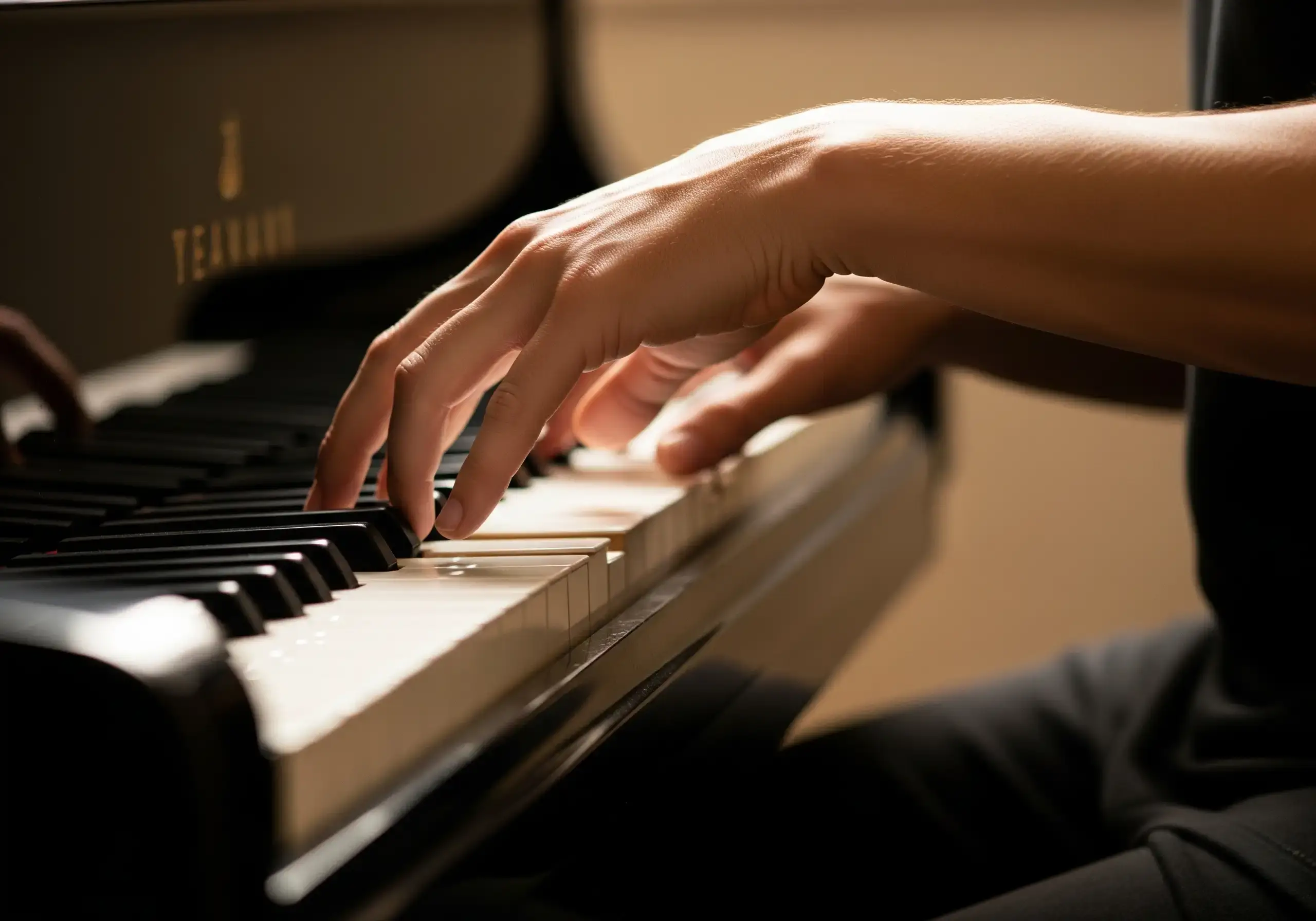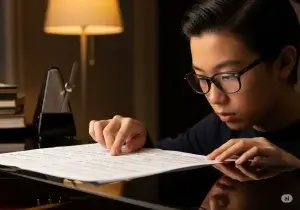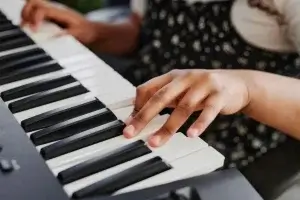Your piano bench position has a surprisingly profound effect on your playing. This post will cover appropriate bench height and distance from the piano, what type of bench to use, and common mistakes.
Why do we need to talk about this? Because playing the piano is a physical act, and we need to position ourselves relative to the piano in a way that: 1) feels good and 2) makes playing feel easy.
If we’re seated improperly, we’re fighting against our bodies and have to put more effort into playing. In some cases, pain and fatigue will result. So read on to learn how to sit properly and protect your body at the piano.
What should you sit on?
We’ll start with what type of bench to use. First of all: actually sit down to play the piano. If you stand while playing, you’re expending physical and mental energy on having to hold your body up. Playing piano is supposed to feel easy, so sit down on something.
However, not all chairs, benches, etc. are created equal, so we have to find a suitable seat. What should we sit on?
An adjustable piano bench, of course. A decent bench is around $100. If you’re serious about playing the piano and already have the instrument itself at your disposal, then a bench is a worthwhile investment.
There are two kinds of adjustable benches:
- Folding bench: with notches underneath for adjusting height
- Concert bench: with knobs on the sides for adjusting
The benches with knobs are superior, as you can adjust it to literally any height rather than at intervals, but the folding bench is just fine if you want a cheaper option.
What should you NOT sit on?
Basically anything else. This includes:
- A chair with wheels: You will have work to keep yourself stable and rooted to one spot while playing the piano. It’s a waste of energy and it distracts your focus from the music you are playing.
- A plushy or excessively padded seat: Examples include a high-end dining chair or an armchair. The squishy padding causes your sit bones to wobble around as you play, compromising stability. Again, it’s wasted energy.
How to sit at the piano:
- Sit on the front half of your bench: This facilitates sitting up straight, and allows you to bend your torso forward (from the hips) ever so slightly, without rounding your back. It also makes leaning from side to side easier (which we sometimes have to do when playing at the extreme ranges of the piano, or when crossing one hand over the other).
- Shoulders down and relaxed: Your shoulders should feel like they’re “floating.” If you raise them while you play, you’ll create tension down the arm. If you retract your shoulders too much, or slouch forward, you’ll inhibit your arm movement at the piano.
How to determine bench height:
With your hands on the piano, your elbows should be level with or just above the white keys. This way, the weight is balanced from the elbow to the tip of the finger.
As Robert Durso, expert on the Taubman approach (a set of techniques meant to optimize piano playing efficiency and eliminate tension), explains, if you are seated too low, your elbow will take most of the weight; if seated too high, it will be your wrist. It goes without saying that these respective joints will then begin to experience pain.
How to determine bench distance:
Make a fist and extend your arm (without bending your elbow) to the fallboard of your piano (or to the back end of the keys, if you have a digital piano). You should be able to keep a straight arm from shoulder to fist when you reach the end of the keys. If you can’t, push your bench further back.
This method is effective because it takes into account the length of your arm and torso, which is what’s relevant when determining seat distance and height (rather than using your full height as a guide).
If you’re not used to this distance, it might seem far away at first. That’s okay. As you get used to it, you’ll find that the extra room you have to move your arms makes playing piano easier.
This healthy distance between you and the piano has another benefit: you won’t have to twist your hand when playing keys right in front of your body (such as middle C).
When you twist your hand (i.e. palm down, but cocking the wrist to one side), you “cut off your hand from your arm” – meaning your hand and arm are no longer working together to play. This creates excess tension, and impedes your ability to lift the hand easily.
Watch Robert Durso demonstrate the difference between a twisted hand and a free hand. (Don’t bother trying it the wrong way, as he demonstrates; it just hurts. All you need is to know what the difference is.) With correct bench distance, you have more room to keep your arm and hand aligned, and hence play with more freedom and without tension.
Bench height in action: some examples
Let’s take a look at two contrasting uses of the piano bench. Note that this is not a comment on the respective pianists’ musicianship; we are simply observing their bench position and how it affects their technique.
FAILING GRADE: Glenn Gould
Glenn Gould is seated too low (obviously), so he has to play with bent wrists, and his elbows will be taking the brunt of the weight when he strikes a key. He’s also seated too close to the piano; he has to cock his wrists to play the keys in front of his body. It’s no wonder that Gould experienced pain from playing piano towards the end of his life.
PERFECT SCORE: Martha Argerich
There are several reasons why Martha Argerich is still able to play the piano at a virtuosic level in her 80s. A huge factor is her impeccable technique, but she’s able to execute that technique properly because of her bench position: notice how her elbows are slightly above the white keys, and she’s seated far enough from the piano to easily access its entire breadth and avoid twisting her wrists.
Conclusion
If you were previously unsure how to position yourself at the piano, now you know how to adjust your bench properly. If you have been experiencing pain at the piano (whether in your arms, neck, or back), optimal bench position can help in eliminating at least some of it. Our hands are not isolated from the rest of our body; we have to take our entire body into account when playing piano. Bench position will have a causative effect on how you feel physically while playing, and if you position yourself properly, the effect will be positive. Happy playing!





